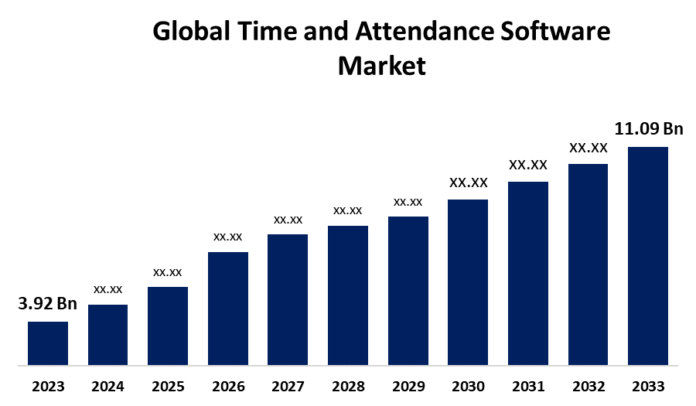The global time and attendance software market is likely to reach as high as $11.09 billion through 2033 and will be computed at a CAGR of 10.96%. This rate is mainly anticipated to come primarily because all businesses are increasingly looking to achieve further efficiency in their workforces and increased productivity. The software, tracking employee working hours, attendance, and other fundamental data, has rapidly become more indispensable for all other industries around the globe.
What is Time and Attendance Software?
Time and attendance software is responsible for tracking and recording when the employees come into work and go out of it. It covers hours worked, absences, and overtime among others. This is of great use in companies that comply with labor and payroll laws and regulations.
These systems can be used in very many ways; from simple tools that track times to advanced software integrating into payroll systems for an all-in-one solution about employee work schedules, pay, and benefits.
Driving Factors of Market Growth
The following are a few of the most notable drivers leading to the rapid growth of the time and attendance market:
Automate the Manual Processes Many organizations have shunned the traditional paper-based attendance records, which includes punch cards and spreadsheets. They were both cumbersome and prone to errors. Software for time and attendance automates these processes in such a manner that tracking of employee work hours will become easier and not prone to mistakes.
Increased Employee Productivity: In most companies around the world, the focus has increased over time to maximize employee productivity. With time and attendance software, businesses can be sure that employees work scheduled hours. Thus, there is decreased absenteeism and overall efficiency improvement.
Remote work and flexibility. With the rise in remote working, there is a great need for tracking the remote-working employees. Presently, most time and attendance software feature includes GPS tracking and a mobile app which enable the company to track remote-working employees who might be working from home or any other remote location.
Integration with Payroll Systems The other excellent feature that time and attendance software offers is its seamless integration with payroll systems. This allows for the accurate pay of employees as scheduled, while it also saves much time by reducing the risk of payroll errors.
Compliance with Labor Laws: As the business grows, it becomes more and more complicated to maintain compliance with labor laws. Time and attendance software ensures that companies comply with local, state, and national regulations, including overtime, minimum wage, and paid leave.
Key Market Trends
Time and attendance software is changing fast, and there are a few key trends that are shaping the market:
Cloud-Based Solutions: Cloud technology has made it easier for any type of business to incorporate time and attendance software into their business system. Cloud-based solutions can be more affordable and easier to implement for SMEs.
Mobile Accessibility: As the urge for flexibility in organizational access is increasing, most businesses have started providing mobile-friendly time and attendance software that allows employees to check in or out and request leave from their smartphones or tablets.
Advanced Features: The latest software is available with advanced features such as biometric authentication, facial recognition, and artificial intelligence (AI) to improve accuracy and security.
Conclusion
The time and attendance software market is growing rapidly across the globe. Its prospects are very bright because companies will continue to focus on efficiency, productivity, and compliance. In such a scenario, these software solutions will be an essential tool for managing workforce operations. With innovations and features, the market is expected to expand further, providing businesses with even more opportunities to optimize their workforce management systems. By 2033, the market is expected to exceed $11.09 billion, with continued growth in both established and emerging markets.





